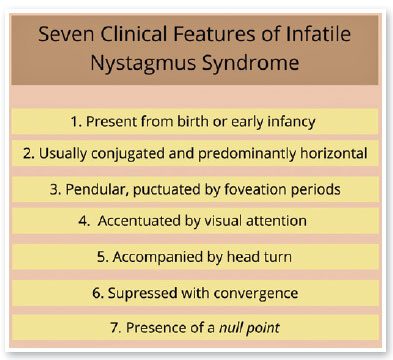Leonardo Eleuterio Ariello
DOI: 10.17545/eOftalmo/2023.0032
In this video, we present the case of a 23-year-old girl with congenital nystagmus and poor vision in both eyes resulting from congenital ocular toxoplasmosis.
Congenital nystagmus, also known as infantile nystagmus syndrome (INS), is a common finding in clinical practice. While some cases are congenital, INS typically develops in early infancy. It is important to suspect visual loss in any patient with INS and conduct a comprehensive ophthalmic examination in all cases1.
Differentiating INS from acquired forms of nystagmus is crucial because new-onset nystagmus in childhood may indicate severe neurological diseases. Ophthalmologists can utilize certain clinical features to distinguish between the two conditions2.
In Figure 1, we present seven clinical characteristics that, although not exclusive to INS, aid in differentiating it from acquired forms of nystagmus. These features should be evaluated in every patient presenting with nystagmus to ensure an accurate diagnosis.

REFERENCES
1. Brodsky MC, Brodsky MC, SpringerLink. Pediatric neuro-ophthalmology. 2nd ed. Springer; 2010.
2. Leigh RJ, Zee DS, Oxford University P. The neurology of eye movements. Fifth edition. ed. Contemporary neurology series. ophthalmology. 2nd ed. Springer; 2010. Oxford University Press; 2015.
AUTHOR INFORMATION

Funding: No specific financial support was available for this study.
Conflict of interest: None of the authors have any potential conflict of interest to disclose.
Received on:
April 17, 2023.
Accepted on:
June 11, 2023.